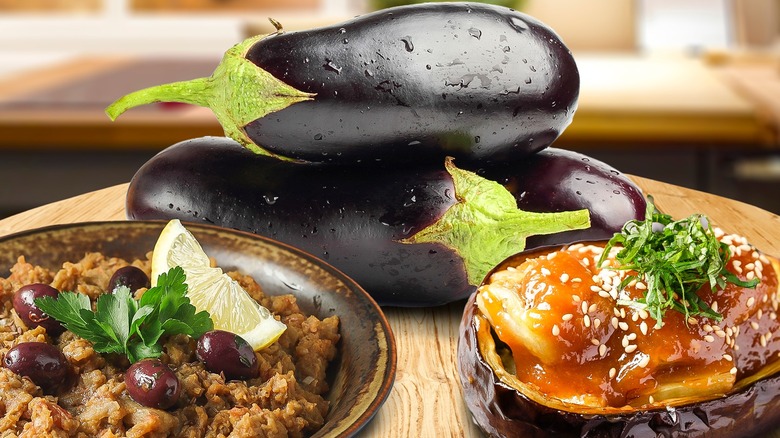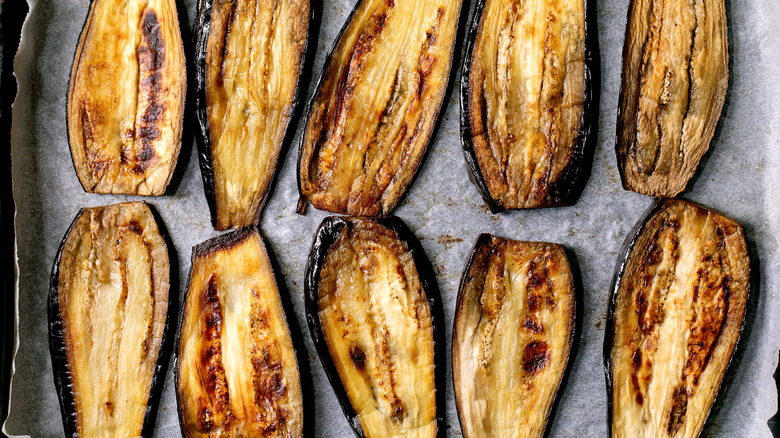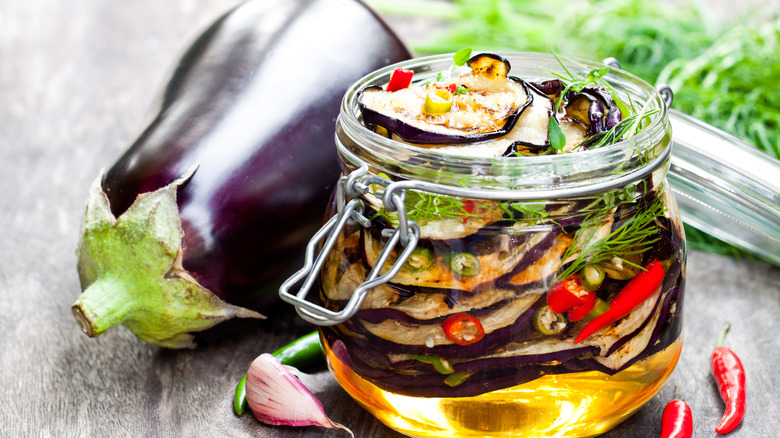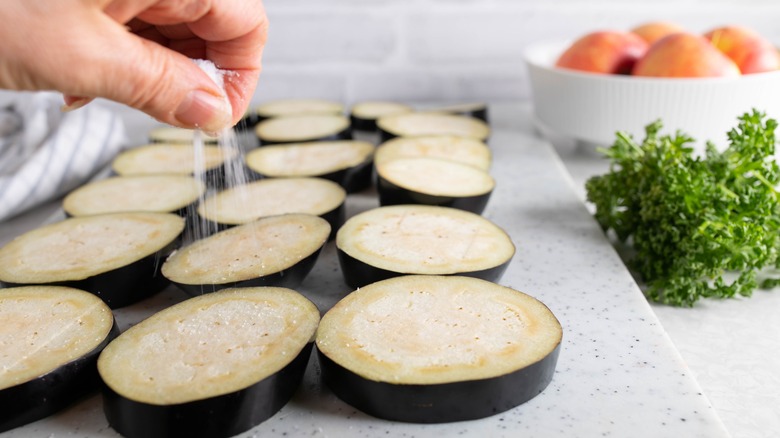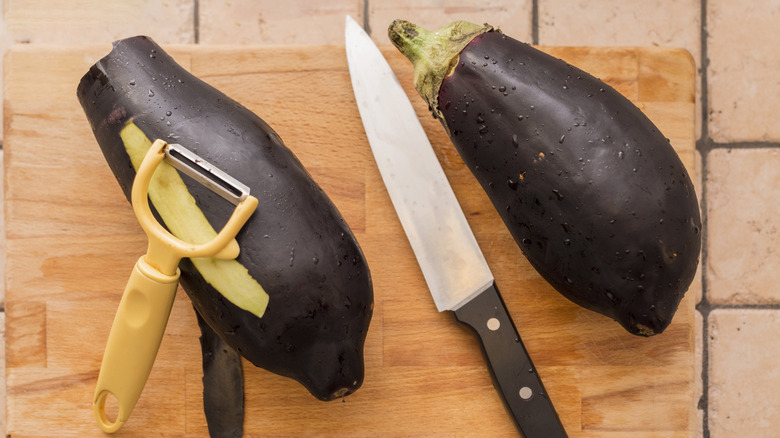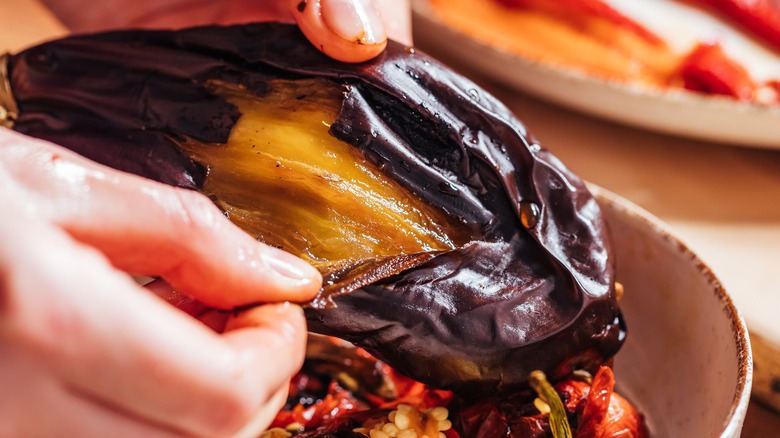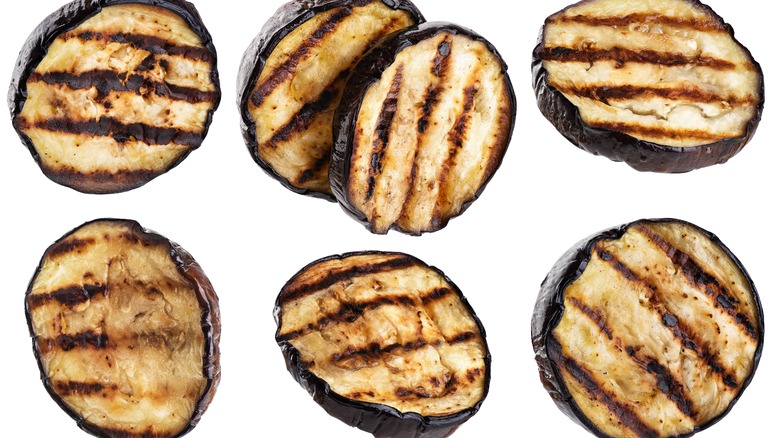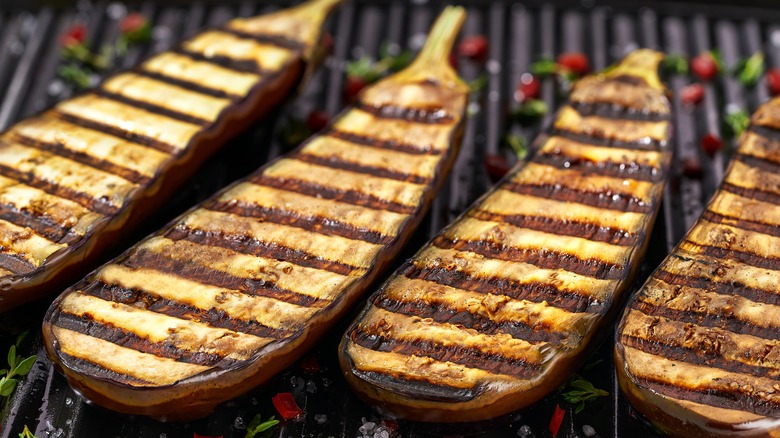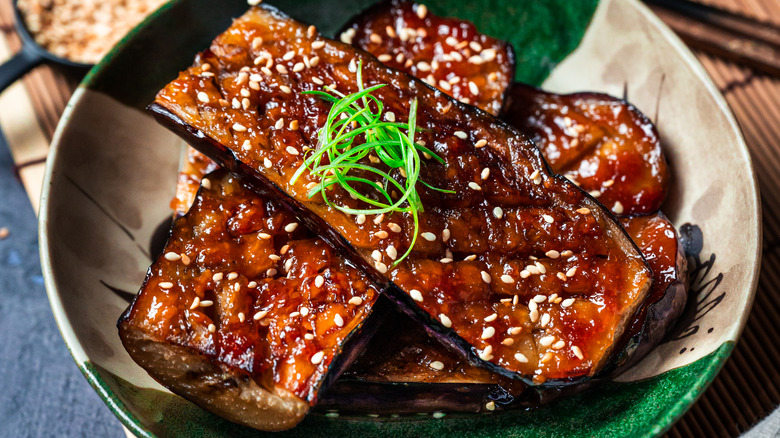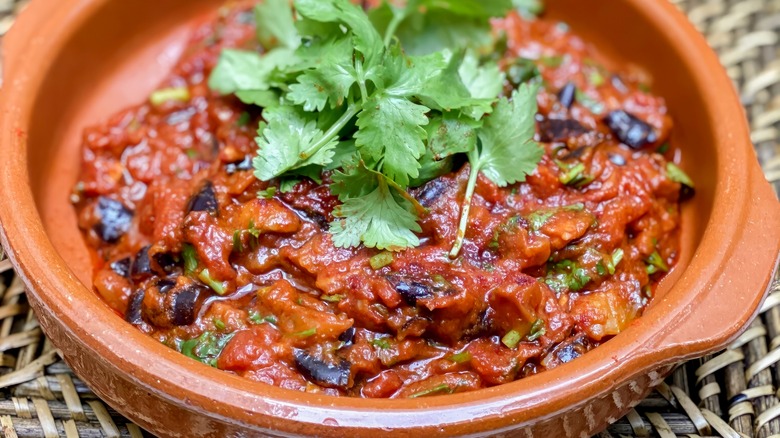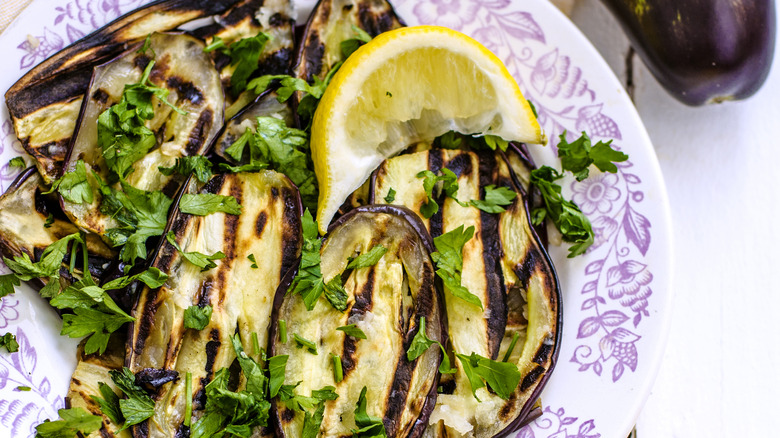11 Foolproof Ways To Make Eggplant Taste Better
Eggplant, known as aubergine or brinjal in different parts of the world, can be a really polarizing vegetable. People who cook it often know the little tricks and secrets to make it taste great. For everyone else, it's an incredibly intimidating vegetable (well, technically, fruit) and doesn't always come out as you expected, especially if you don't know what you're doing. This is what makes people iffy about it when it's actually an ingredient that offers so much flavor, texture, and versatility.
When you have the right tips for cooking with eggplant, it can be heavenly. Many people love it for its meatiness, smokiness, silkiness, or creaminess, which all depend on how you cook it. And there are multiple ways to cook it, including grilling, frying, steaming, mashing, braising, roasting, and more. It's also great at absorbing flavor, so it makes the perfect vessel for an umami-packed sauce or a tangy dressing.
I'm a recipe developer and consider myself an eggplant enthusiast. I cook with eggplant often and have tried possibly hundreds of eggplant recipes in my lifetime. It's also an integral part of my heritage as it features strongly in Middle Eastern dishes. Looking to the cuisines of the world that feature eggplant heavily, like China, Japan, India, the Middle East, the Mediterranean, and beyond, can guide anyone on delicious preparation methods and recipes. If you don't know where to start, here are some foolproof ways to make eggplant taste better.
Roast eggplant slices until well browned
One of the easiest preparation methods I've found for eggplant is to simply slice it into rounds and roast it in the oven until it's gone golden brown. What's great about roasting is that it's almost effortless cooking, as all you have to do is prep your eggplant and the oven does all the rest. Eggplant is also one of those veggies that absorbs oil like a sponge, and can often become too oily when fried. Roasting allows you to add just enough oil to keep everything lubricated and nothing more. It also draws out the excess moisture in the flesh, allowing the eggplant to get crispy if you leave it for long enough.
Cut off the top and bottom part of each eggplant and slice them up. Lay them flat in a single layer on some parchment paper and drizzle them with olive oil. Make sure they're well coated with oil and season with some salt and pepper. This isn't a quick roast, and depending on the thickness, can take up to 40 minutes or longer. Eggplant can, at times, be bitter, which isn't the most appetizing. In my experience, for a slice that's about an inch or just over, 40 minutes at 350 degrees Fahrenheit hits the sweet spot of brown enough that it tastes caramelized and not bitter at all. You can also roast some eggplant slices before adding them to dishes like moussaka or even an eggplant curry; this way they'll soften and become silky in the sauce and not be too oily or spongy, while still tasting great.
Marinate your eggplants in vinegar and oil
Making marinated eggplants is a sure way to inject a lot of flavor into them, and it could possibly win over even the eggplant skeptic. It all comes down to making the perfect marinade, and this is much easier than it sounds. All you need is a combination of something salty, sweet, and acidic. You can think of it as a salad dressing for your eggplants, as essentially, you just need some good quality olive oil, a vinegar of your choice, and some salt. For a pop of sweetness, a squeeze of honey or maple syrup works a treat, and for some added umami, a splash of soy sauce takes everything to the next level. You can also add any extra flavorings that you can think of, from chiles to garlic and ginger.
You may be wondering how on earth does one marinate eggplant? Of course, you can't do it with raw eggplant, and the secret is to first roast the eggplant before adding it to the marinade. As mentioned before, roasting draws out excess moisture in the eggplant, which will, in effect, help it be more absorbent to your marinade. They go from being thin and potentially a little on the dry side to plump, juicy, and flavorful once in the marinade.
Marinating eggplants also semi-preserves them, so you can keep them in the fridge for longer. I like to make a weekly batch of marinated eggplant to add to sandwiches, salads, flatbreads, and more. They're sure to make a lunchtime toast a gastronomic experience or even be a favorite on an antipasto platter you might serve with drinks with friends or for an easy dinner.
Toss them in a batter and fry them up
One sure way to make tasty eggplant is by slathering it in a fluffy batter and frying it up. A quick fry in hot oil ensures the eggplant doesn't have enough time to absorb too much oil, while still getting soft in the middle and crispy on the outside. Plus, the batter provides you an opportunity to add all kinds of seasonings to add even more flavor. Spices like paprika, garlic powder, onion powder, ground cumin, and more can all make for one tasty fried eggplant.
Eggplant can be sliced into round discs or even into stick shapes lengthwise. Frankly, whatever way you (literally) slice it will work fine. However, because you want them all to cook as evenly as possible, it's always best to cut them in equal sizes. Using a mandoline slicer can be helpful to achieve this. Generously coat all the eggplant in batter and place them in your pan when the oil has become hot enough. A good test in my experience is to drop a little of the batter in the oil. If it sizzles vigorously and rises to the top, the oil is hot enough to fry. Once they've turned golden brown, remove them and place them on paper towels to remove any excess oil. Serve with any sauce of your choice, but this easy yogurt and cardamom sauce would be a great choice.
If you prefer to use breadcrumbs rather than a wet batter, it's completely possible and equally delicious. You can season your breadcrumbs and even add some grated Parmesan to them for extra saltiness and umami. Generously and evenly coat your eggplant in the breadcrumb mix and pack them in with your hands. Fry in hot oil until crispy on both sides.
Salt your eggplant before cooking
Much of my childhood memories of eating eggplant involve it being laid out all over the kitchen covered in salt for hours on the day of preparation. My mother explained that this technique drew out some water from this porous produce, helping prevent it from getting soggy and absorbing too much oil while cooking. It also draws out any bitterness from the eggplant, so it would taste sweeter. Checking in on the eggplant after a couple of hours, they would be covered in drops of water that had "sweated" out of it. Nowadays, eggplant varieties are generally less bitter, but it can still be a good idea to salt your eggplant to eliminate any bitterness that they may still have and give them a better texture for frying and more. Plus, it will season your eggplant better as some salt will absorb deeper into the flesh.
Another way to go about it is with this brining tip for more delicious eggplant. Instead of using just salt, using a saltwater brine works with the same logic, as the salt draws out excess moisture and bitterness from the eggplant. After taking the eggplant pieces out of the brine, they need to be rinsed and patted dry before cooking.
Don't peel your eggplants if you don't have to
There's always a little debate between home cooks about whether it's necessary to peel an eggplant. Depending on how you cook it, the skin may sometimes make the texture a little tougher, and some believe the skin is the part of the fruit to blame for the bitter taste. So, a lot of people think peeling an eggplant is the solution to avoiding all this. However, as the skin contains a lot of flavor and even some beneficial antioxidants, it should be noted that it's not necessary to peel an eggplant — unless a recipe explicitly depends on a skinless eggplant.
The trick with eggplant skin is that it cooks a little slower than the flesh, which can soften quicker. This is what causes the sometimes hard to chew texture when you come across the skin, it's simply undercooked. To make sure the skin cooks, it's always a good idea to cook eggplant for longer than you think. If you're unsure, there's nothing more foolproof than just tasting a piece. If the whole piece, including the skin, is tender and easy to eat, then it's ready.
Roast them whole for a creamy dip
There are so many ways to cook an eggplant that sometimes it can be tricky to know where to start. Well, if you're looking for the most fuss-free method of all, then roasting whole eggplant is the go-to method for a smooth texture. It couldn't be easier; no peeling, no cutting, and no oiling up required. Make sure to rinse and pat them dry first. Then, place them over some parchment paper in a baking tray in the oven at 350 degrees Fahrenheit for about an hour.
This method yields a wonderfully soft and silky eggplant that you'll want to eat whole, too. Additionally, the skin tends to shrivel a little and becomes really easy to peel if you prefer to remove it. Or, for an even easier trick, you can often just scoop out the flesh with a spoon. You can then serve this flesh in a salad, over some rice, or in a creamy sauce. This is also the way people use the flesh to make the popular Middle Eastern eggplant dips like baba ganoush. You don't even need a blender or food processor as you can just mash the eggplant flesh with the other ingredients and, voilà.
Season them generously
Eggplant has a lot of flavor on its own, but this doesn't mean it shouldn't be well seasoned. This is a mishap some people make, thinking that roasting, frying, or however you cook eggplant is enough to make it taste good. In truth, it may look and act differently to various other fruits and vegetables, but this doesn't mean that it doesn't still need a good amount of salt, pepper, spices, or seasoning sauces to bring out and highlight the best parts of its flavor. You need to season it just how you would a potato, zucchini, cabbage, etc. Plus, since the flesh tends to be quite thick, it can take a little extra seasoning.
Salting your eggplants or doing a salt water brine is a good way to make sure the salt has permeated into the flesh enough. Alternatively, you can just season it generously before or during the cooking. Other than salt and pepper, spices like garlic powder, paprika, ground cumin, ground chile, ground coriander, and even cinnamon and nutmeg work great. Or you can do the blend route and use Chinese five spice, garam masala, or something like Lebanese baharat.
Grill them on the barbecue
You're mistaken if you think the grill is reserved for meat, as grilled eggplant is the dish you want to serve at your next barbecue. Grilling allows you to get them nice and charred, getting those sought-after grill marks that are a sign of deeply caramelized and smoky flavor. Since eggplants are a hardier fruit, they're stable enough to put on the grill and still hold their shape really well. While the classics like coleslaw, potato salad, or grilled corn are hard not to love, they can get a little boring, and grilled eggplant is an innovative addition to the menu. As it's quite a "meaty" fruit, it's also the perfect choice of what to grill for a vegan or meat-free meal.
Cut the eggplants into thick, long slabs by slicing them lengthwise. You want a large enough surface area that they'll develop grill lines, and that you'll be able to flip them over with no problems. You can keep it simple and just brush them with some olive oil, salt, and pepper, or make a sticky glaze for them with a mix of soy sauce and honey (that you should add near the end of cooking so that the honey doesn't burn). Or take inspiration from Jamaican grilled eggplant and give them a flavor-packed jerk seasoning.
Coat them in miso
A sure way to make most things taste amazing is to add some miso paste. It's no different with eggplant, and in fact, miso and eggplant are a match made in heaven. The salty, sweet, umami, and smoky notes of miso are almost mirrored in eggplant, which has all those notes, too. The two ingredients have powerful yet mild flavors and are instantly improved by each other's presence. If that's not enough to convince you, you've got to try it out for yourself. A Japanese friend recommended that I try this combination years ago, and I haven't looked back since. This dish, called nasu dengaku in Japanese, is made with a miso glaze, which you usually prepare with ingredients like mirin, sugar, oil, and sesame seeds, among other optional additions like soy sauce, sake, etc.
The trick with adding a miso glaze is to cook the eggplant (whether you halve or quarter it, or roast or grill it) until it's almost ready. You mix the glaze ingredients together while the eggplant is cooking and then add it to the cooked eggplant and broil for the final few minutes until it caramelizes. As there's sugar in the glaze, be careful not to leave it for too long or it can burn. For even deeper flavor, score the flesh side with a little cross-hatch pattern, but make sure not to cut all the way through. This way, your eggplant will stay intact, but the glaze will fill the gaps made from scoring and caramelize even more.
Try Moroccan zaalouk
You may know and love baba ganoush, but unless you're very familiar with North African cuisine, it's likely that you've never heard of Moroccan zaalouk. This eggplant dip is quite different from the others in the sense that it's cooked and also bursting with sweetness, brightness, and spice. Traditionally made with a base of both eggplant and tomatoes, zaalouk has all the smoky and velvety notes of eggplant with the added acidity and sweetness of tomatoes. Added to this near-perfect flavor profile are tons of garlic, paprika, lemon, cumin, cayenne pepper, and more. It's a celebration of spice on your tongue. It's also a really nifty recipe to have on hand as it's totally vegan, gluten-free, and can be eaten hot or cold.
You start off by roasting eggplants whole in the oven, the way you would for a dip like baba ganoush, where, once cooked, you scoop out the soft flesh, leaving the skins behind. This flesh is then added to a simmering pot of all your other zaalouk ingredients, like the tomatoes, garlic, olive oil, and spices, until it develops in flavor and has thickened into a chunky dip. You can garnish zaalouk with some fresh cilantro and parsley, some lemon slices, and a drizzle of olive oil. Some fresh crusty bread is all you need to dunk into the dip and find your new favorite way to eat eggplants.
Saute them with garlic and lemon
If you love the taste of eggplant and want to cook up a tasty dish quickly, without needing to think too much about technique, then a simple saute in some oil with garlic and a squeeze of lemon will hit the spot. This is especially the case if you have fresh eggplants that haven't been sitting out too long and likely won't have any bitterness at all. No prior salting or peeling of the skin is needed.
Slice them into rounds, chunks, squares, sticks, or whatever you want them. Any shape will work as long as they are fairly bite-sized. Warm some olive oil on medium heat and add the eggplant pieces. Saute them around in the hot oil until they turn light brown and soften. Then, throw in some grated or chopped fresh garlic and toss so the eggplant is mixed in with the garlic. Once the garlic has sizzled and cooked (but before any burning), turn off the heat, and generously sprinkle some salt and a squeeze of lemon juice on the eggplant. For more freshness, add some parsley. Serve as a side dish or eat with some steamed rice and tahini dressing for a light meal.
